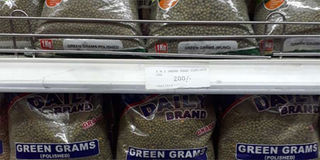Breaking News: KDF chopper crash kills five
Green grams glut exposes flaws in the local market

Green grams retailing at Sh200 per kilo on the shelves of Naivas Supermarket in Kitui Town. Brokers are buying a kilo from farmers at Sh40. PHOTO | KITAVI MUTUA | NMG
What you need to know:
- Kenya has been a net importer of green grams from the East African community to cover an annual domestic shortfall.
- The country has become an attractive market within the EAC for green grams consumption, where cheap imports of the grain easily flow in to cover the deficit.
The green grams glut being experienced by farmers in Kitui, Makueni, Tharaka Nithi and Meru counties has exposed disturbing contradictions on domestic production and demand that result in price manipulation.
Whereas local farmers are frustrated by lack of a ready market following depressed foreign demand from Asian countries, it has emerged that Kenya has been a net importer of green grams from the East African community to cover an annual domestic shortfall.
Statistics by the Ministry of Agriculture indicate that the estimated national annual consumption of green grams stands at an average of 130,000 metric tonnes, way above the annual domestic supply.
The economic review on agriculture sector conducted between 2014 and 2016 shows that Kenya’s average production of 103,234 metric tonnes falls significantly below the consumption and trade requirements.
The production shortfall shows that local farmers are yet to satisfy the domestic demand and should not, therefore, be looking for a foreign market for their produce.
Kenya, due to its strong currency compared to her neighbours, has become an attractive market within the EAC for green grams consumption, where cheap imports of the grain easily flow in to cover the deficit.
The contradiction in local demand and supply trends exposed in economic surveys obtained by the Sunday Nation also reflects the huge variation of prices of the crop within the country.
Interestingly, in the midst of the current glut, a kilo of green grams is retailing at a whooping Sh200 at all the leading supermarkets – more than five times the average price of Sh40 per kilo being offered to farmers by brokers.
Farmers see this price contradiction as a conspiracy by unscrupulous brokers to exploit them to rake in millions of shillings in profits by merely packaging the produce in one kilogramme packets.
This means the glut arising from a bumper harvest has disrupted local market dynamics and caused a significant drop in prices. But this can be reversed with minimal government policy interventions, according to analysts.
Experts say after India – the targeted market – banned imports to protect their farmers, the glut was artificially created by middlemen who took advantage of vulnerability of most Kenyan farmers in post harvest handling.
Farmers in the four counties are, therefore, forced to sell their produce – commonly known as ndengu or pojo in Kiswahili, in a hurry and at throw away prices to avoid the grain going to waste because it is highly prone to attack by weevils.
According to Gabriel Kitetu, the project coordinator of Accelerated Value Chain Development (AVCD) Programme at Farm Africa, green grams farmers should be protected from the cheap imports to increase local demand of their produce.
Mr Kitetu told a stakeholder meeting held at World Agroforestry Centre, Nairobi, that Kenyan producers have the opportunity to meet domestic demand, before eyeing the export market.
“Kenya has been importing green grams from Uganda, Tanzania, Rwanda, Ethiopia and DRC over the years. This simply means our farmers are not satisfying the domestic demand,” he said.
The solution, he added, lies in helping green grams farmers improve and modernise their storage capacity where they can sell the produce later, spread throughout the year as per the domestic market demand.
As agricultural experts and officials from the four counties grapple with how to deal with the glut to cushion farmers from possible losses and prevent the crop from going to waste, poor post-harvest handling has been cited as the biggest challenge.
The stakeholders want the government to impose a total ban on importation of green grams to protect producers, but also support production.
“We must invest in production technologies to increase efficiency and cost-effectiveness to compete with other producers within East Africa region and be competitive on the global market,” said Mr Kitetu.
Dr Moses Siambi, the Regional Director at Icrisat in-charge of Eastern and Southern Africa, said the ndengu glut was normal and that stakeholders should work together to provide solutions to farmers.
Dr Siambi said over the years, the Kenyan green grams have ended up in the Asian markets but ordinarily, any fluctuation in India’s market tends to have a direct effect on global prices.
To address the gaps, Kitui Governor Charity Ngilu has struck a deal with USAid and Icrisat to develop post-harvest storage strategies to hold the produce until the prices improve. In the deal, local farmers will be supplied with new grain storage hermetic bags at subsidised rates to help them curb post-harvest losses.
“Each empty hermetic bag costs Sh200 but as stakeholders, we’ve agreed to share the cost between the farmer, the county government and USAid, in a 40:30:30 ratio,” said Dr Romano Kiome, Chief of Party for the Accelerated Value Chain Development (AVCD) Programme.
The former Agriculture PS said farmers will pay only Sh80 per bag, which will help them fight the scourge of weevils on stored grains.
“The new bags are effective because weevils cannot damage the produce,” he said.
He added most farmers have hurriedly sold off their produce due to lack of storage facilities and as such, they are at the mercy of brokers who offer poor prices. He said the bag would put an end to this trend.




